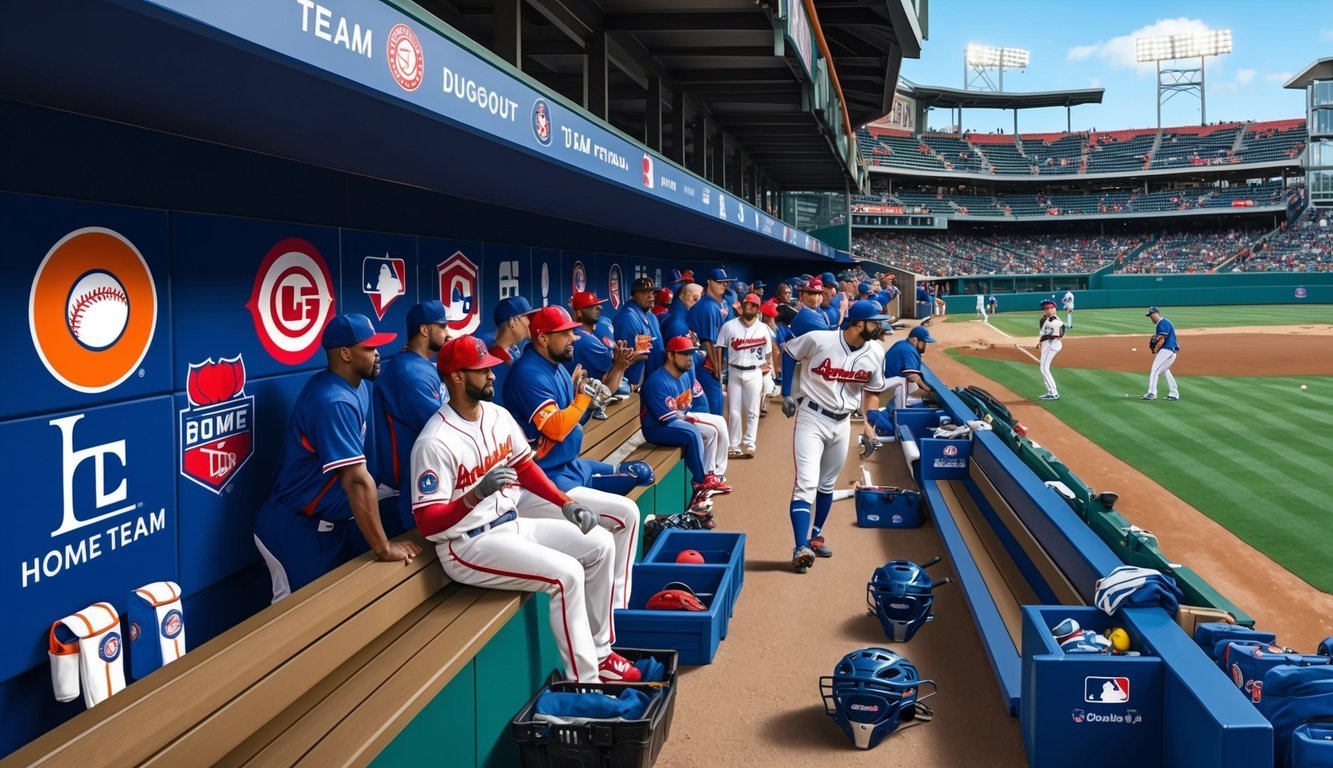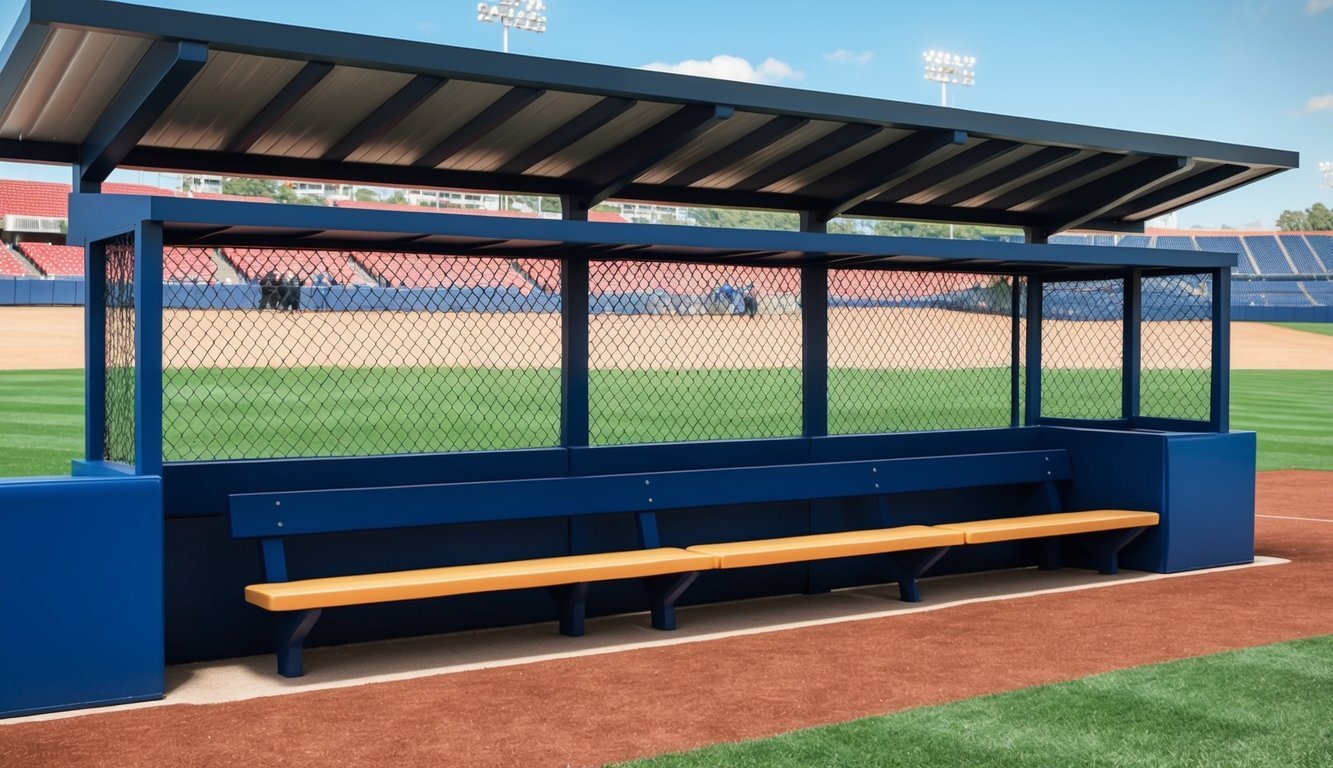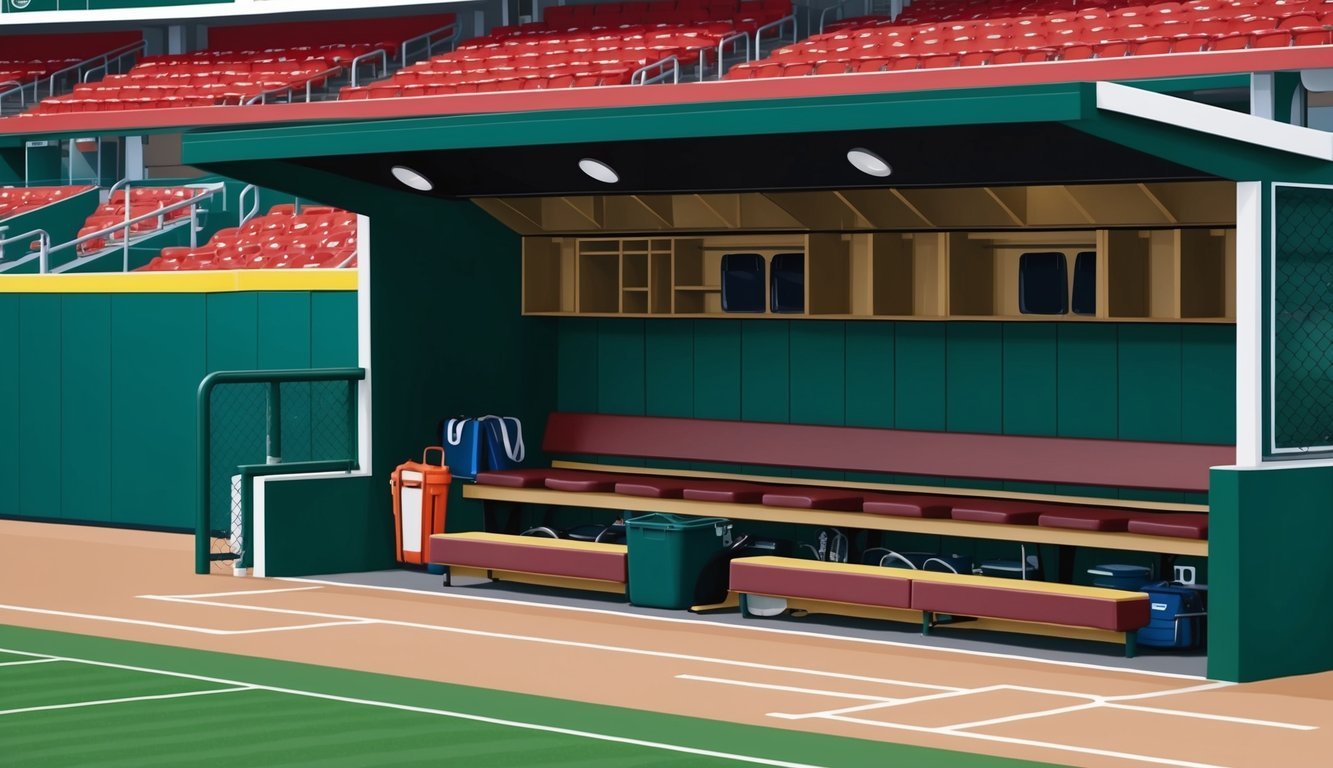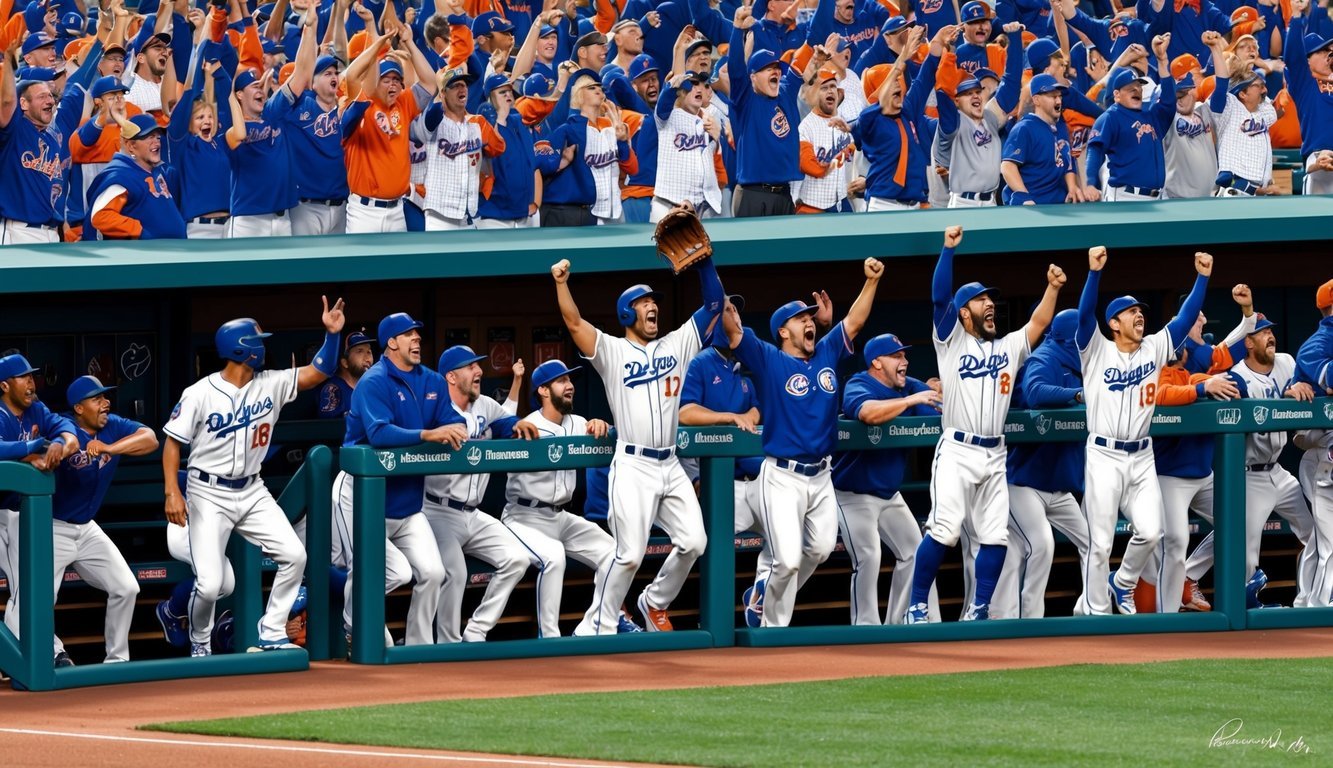Baseball fans often wonder about the seating arrangements at the ballpark, especially when it comes to the teams’ dugouts.
The dugout serves as a crucial hub for players and coaches during the game, providing shelter and a strategic vantage point.
In Major League Baseball, the home team typically occupies the first-base dugout, while the visiting team takes the third-base side. This arrangement is a long-standing tradition in most MLB stadiums.
However, it’s worth noting that some ballparks have exceptions to this rule due to historical or practical reasons.
The choice of dugout can impact team dynamics and strategy.
Home teams often prefer the first-base dugout for its proximity to their bullpen and better visibility of the field.
This placement allows for easier communication between coaches and players, potentially giving the home team a slight advantage during crucial moments of the game.
Basics of the Baseball Dugout

Dugouts are an essential part of any baseball field, serving as a hub for players and coaches during games.
These sunken areas provide shelter and strategic positioning for teams.
Definition and Purpose
A baseball dugout is a designated area near the playing field where team members not currently on the field gather during a game.
It’s typically below ground level, offering protection from the elements and flying balls.
Dugouts house players, coaches, and equipment, keeping them close to the action.
Dugouts serve multiple purposes:
- Provide a clear view of the game
- Allow quick player substitutions
- Facilitate team communication
- Store equipment and supplies
Players use dugouts to rest, strategize, and stay focused between innings or at-bats.
Coaches often position themselves at the dugout entrance to relay signals and instructions to players on the field.
Dugout Design and Layout
Baseball dugouts are designed for functionality and comfort.
Most are rectangular, stretching from home plate towards first or third base.
The layout typically includes:
- Bench seating for players and coaches
- Bat and helmet racks
- Water coolers and cups
- Hooks for jackets and gear
- First aid supplies
Some modern dugouts feature padded benches, air conditioning, and even video screens for reviewing plays.
The roof extends beyond the dugout to shield occupants from sun and rain.
Stadium architects often incorporate team colors and logos into dugout designs, adding a personal touch.
The size and amenities can vary greatly between professional and amateur fields, but the basic layout remains consistent across all levels of play.
Positioning of the Home Team Dugout

The location of the home team’s dugout in baseball varies across different stadiums and leagues.
Factors like stadium design, tradition, and team preferences influence where the home team sets up shop.
Determining Factors
Stadium layout plays a crucial role in dugout placement.
Some ballparks have the home team on the first-base side, while others opt for the third-base side.
Sun position is another key consideration.
Teams often choose the dugout that shields players from glare during afternoon games.
Strategic advantages come into play too.
The third-base dugout allows for better communication between the third baseman and the bench.
It can also give batters a clearer view of incoming pitches.
Local customs and historical precedent sometimes dictate dugout assignments.
For example, some teams have occupied the same dugout for decades, regardless of potential benefits from switching sides.
Home Team Dugout Traditions
In Major League Baseball, most teams follow a first-base dugout tradition for the home team.
This setup is common in both American and National Leagues.
However, exceptions exist.
The Boston Red Sox famously occupy the third-base dugout at Fenway Park.
It’s a long-standing tradition that adds to the park’s unique charm.
Some other MLB teams, like the Chicago Cubs at Wrigley Field, also break from the norm.
Minor leagues and amateur baseball often have different practices.
Little League fields, for instance, may assign dugouts based on field availability or local preferences.
Teams usually stick to their assigned dugouts throughout the season.
This consistency helps players, coaches, and fans know where to expect their home team during every game.
Influence of Sun and Shade
Sun and shade play a crucial role in determining dugout comfort and player performance.
The position of the dugout relative to the sun’s path can significantly impact visibility and temperature for players and coaches throughout a game.
The Impact on Players and Coaches
Direct sunlight can affect a player’s ability to see the field clearly.
Batters facing the sun may struggle to track pitches, while fielders might lose fly balls in the glare.
Coaches in a sun-drenched dugout may find it challenging to observe and analyze plays effectively.
Shade provides relief from heat, especially during day games in summer.
Players can stay cooler and more focused when not constantly exposed to the sun.
This can lead to better performance and reduced risk of heat-related issues.
Some teams strategically choose their dugout based on sun position to gain a competitive edge.
A shaded dugout can help players stay refreshed and alert throughout the game.
Stadium Orientation and Dugout Comfort
Stadium designers often consider sun angles when planning dugout locations.
Ideally, both dugouts should receive equal sun exposure to maintain fairness.
However, this isn’t always possible due to existing site constraints.
Many ballparks orient home plate to face northeast, minimizing late-afternoon sun glare for batters.
This orientation typically places the third-base dugout in shade earlier in the day.
Some stadiums have retractable roofs or awnings to provide additional shade.
These features can help balance sun exposure between dugouts and enhance overall player comfort.
Teams may install fans, misters, or cooling systems in dugouts to combat heat.
These additions can make a significant difference in player comfort, especially in stadiums where one dugout receives more direct sunlight than the other.
The Dugout as a Strategic Base

The dugout serves as a crucial hub for team operations during a baseball game.
It provides a space for strategic planning, equipment management, and player coordination.
Game Strategy and Team Management
The dugout is where managers and coaches analyze the game and make critical decisions.
They use this vantage point to observe opposing pitchers, study defensive alignments, and decide on lineup changes.
Managers often keep detailed notes and use tablets to access player statistics and scouting reports.
Communication is key in the dugout.
Coaches relay signs to batters and baserunners, while players share insights about the opposing team’s tactics.
The dugout’s location allows for quick conferences between innings, enabling the team to adjust their strategy as the game progresses.
Equipment and Facilities
Dugouts are equipped with essential gear for players.
Bats are neatly arranged in bat racks, while helmets and gloves are kept within easy reach.
Many modern dugouts feature water coolers, energy drinks, and snacks to keep players hydrated and energized.
Coaches often utilize whiteboards or clipboards to strategize and share game plans with their team.
In addition to the bats and helmets, you’ll often find catchers gloves for baseball players hanging on hooks, ready for quick access during games.
This organized setup not only facilitates smooth transitions between plays but also fosters a sense of teamwork and readiness among the players.
Comfort is also a consideration.
Benches provide seating for players and staff, while some dugouts have heating or cooling systems for extreme weather conditions.
Trainers often set up a small area in the dugout to address minor injuries or provide quick treatments.
The baseball rulebook specifies certain regulations for dugouts.
For example, Little League rules limit the number of adults allowed in the dugout to ensure adequate space for players.
These guidelines help maintain order and safety in this important team space.
Role in Fan Experience and Game Day Dynamics

The home team dugout plays a crucial part in shaping the fan experience and influencing game day energy.
Its location and setup can significantly impact spectator engagement and team performance.
Visibility and Proximity to Spectators
Fans often seek seats near the home team dugout for a closer connection to their favorite players.
These prime locations offer unparalleled views of player interactions, warm-up routines, and in-game strategies.
Many stadiums design seating areas that curve around the dugout, maximizing visibility for spectators.
Some ballparks feature open dugouts, allowing fans to see players more easily.
This design choice enhances the overall experience, making fans feel more involved in the game.
Proximity to the dugout also increases chances for autographs and memorabilia.
Players often toss balls or other items to nearby fans between innings, creating lasting memories.
Home Team Advantage and Atmosphere
The home team dugout contributes to a sense of familiarity and comfort for players.
This can boost confidence and performance, especially during crucial moments in the game.
Fans seated near the dugout often create a lively atmosphere.
Their cheers and support can energize players, potentially influencing the game’s outcome.
Many teams customize their dugouts with team colors, logos, and motivational messages.
These elements reinforce team identity and pride, both for players and spectators.
The dugout’s location can also affect player-fan interactions.
Post-game celebrations often start near the dugout, allowing fans to join in the excitement more directly.
